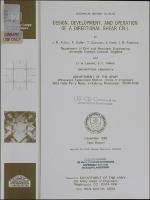Please use this identifier to cite or link to this item:
https://hdl.handle.net/11681/12657| Title: | Design, development, and operation of a directional shear cell |
| Authors: | University College, London. Department of Civil and Municipal Engineering Arthur, J. R. F. Cutler, F. Dunstan, T. Ford, J. Pulsford, J. R. Leavell, Daniel A. Peters, John F. |
| Keywords: | Anisotropy Multiaxial loading Cubical triaxial Plane strain Strains Directional shear Simple shear Shear strength of soils Soil testing Soil tests Equipment Directional Shear Cell |
| Publisher: | Geotechnical Laboratory (U.S.) Engineer Research and Development Center (U.S.) |
| Series/Report no.: | Technical report (U.S. Army Engineer Waterways Experiment Station) ; no. GL-89-16. |
| Description: | Technical Report Abstract: The directional shear cell (DSC) prototype was commissioned by the US Army Engineer Waterways Experiment Station (WES) with the aims of carrying out basic research and eventually the routine testing of undisturbed samples from the field under stress paths including controlled rotation of the principal stress axes. The new design evolved from experimentation and a wide range of discussions between WES personnel and the research team at University College, London, England. Advances were made from previous versions of the DSC. For example, in this prototype, testing is completely automated (including cyclic tests) with the capability to rotate the principal stress axes through 360 deg. The new version also has a significantly higher stress capacity. The aim throughout apparatus development was to produce a device which would be easy to work with. In particular, the original apparatus design required the operator to use judgment in adjusting the positions of the normal-pressure bags and the alignment of the shear sheets as the specimen deformed. It was considered very important to make these adjustments automatic and therefore objective. There are many possible research areas that can be pursued using the new DSC. An important area for practical applications is assessing the performance of various types of constitutive models for soils by imposing complex stress paths that replicate prototype loading. Areas of research for improvement of the apparatus include quality of strain measurement and automation, comparative studies of other shear apparatuses, lubrication, and specimen preparation. |
| Rights: | Approved for public release; distribution is unlimited. |
| URI: | http://hdl.handle.net/11681/12657 |
| Appears in Collections: | Technical Report |
Files in This Item:
| File | Description | Size | Format | |
|---|---|---|---|---|
| TR-GL-89-16.pdf | 8.78 MB | Adobe PDF |  View/Open |